Quantitative Easing (QE2): Who Gets the Fed’s Printed Money?
Interest-Rates / Quantitative Easing Oct 26, 2010 - 08:49 AM GMTBy: Chris_Ciovacco
 Part 2 of a 6 Part Video Series on Quantitative Easing: In Part 1: Quantitative Easing Targets Asset Prices, Not Bank Reserves, we discussed how Mr. Bernanke’s quantitative easing program is implemented via the Fed’s eighteen primary dealers, not traditional banks.
Part 2 of a 6 Part Video Series on Quantitative Easing: In Part 1: Quantitative Easing Targets Asset Prices, Not Bank Reserves, we discussed how Mr. Bernanke’s quantitative easing program is implemented via the Fed’s eighteen primary dealers, not traditional banks.
We do not know the size of the Fed’s program, nor do we know how the markets will react in the short-term. However, one thing we know with near certainty – a large quantity of newly printed money is going to flow from the Fed to the eighteen primary dealers. We also know a significant amount of the electronic greenbacks will flow from the primary dealers into the accounts of their clients.
Since the Fed encourages the primary dealers to offer client bonds in the QE competitive bidding process, it is helpful for investors to know more about the clients of the primary bond dealers. Sovereign wealth funds, who do business with numerous primary dealers, will be one of the most influential groups who may participate in QE2. A sovereign wealth fund is a state-owned investment fund, which holds a wide variety of financial assets, including stocks, bonds, commodities, currencies, precious metals, and real estate.
One of the largest sovereign wealth funds is the Norway Global Government Pension Fund, which holds somewhere in the neighborhood of $400 billion in assets. Others include the China Investment Corporation ($300 billion), Singapore Investment Corporation ($250 billion), Hong Kong Monetary Authority ($225 billion), the Russia National Welfare Fund ($140 billion), and the Australian Future Fund ($60 billion).
To give a hypothetical example of how the Fed’s newly printed money can make its way around the globe, assume the following: (a) concerned about the currency risk associated with holding too many U.S. Treasuries, the Singapore Investment Corporation (SIC) decides to sell some bonds to the Fed via the QE2 program, (b) the Fed takes the Treasuries and the SIC gets newly printed U.S. dollars in return, (c) since holding U.S. dollars also entails currency risk, the SIC decides to diversify into gold, global stocks, and emerging market bonds. This hypothetical example shows how the Fed’s printing press can, in theory, create demand for other assets and thus, help drive asset prices higher. Higher asset prices can help improve strained balanced sheets which can, in theory, spark more spending, investing, borrowing, and hiring (emphasis on in theory).
Understanding the global footprints of the primary dealers and their clients allows us to visualize the broad geographic reach of the Fed’s printing press. Understanding the buying power and investment influence of large clients of the primary dealers, like sovereign funds, helps us understand how QE2 may potentially impact a wide range of markets from currencies to commodities.
The flow chart below shows how the Fed’s newly printed cash can flow from the Fed to the primary dealer, then to the primary dealer’s clients.

With the million dollar question relative to QE2 being the magnitude of the Fed’s planned bond purchases, we can expect some volatile trading sessions for the next week or so. According to a Forbes/CNN article:
Economists at Goldman Sachs estimate the Federal Reserve may need to buy a staggering $4 trillion worth of assets such as Treasury securities to get the economy rolling again. The Goldman economists, Jan Hatzius and Sven Jari Stehn, don’t expect the Federal Reserve to go nearly that far when it resumes its asset-purchasing quantitative easing policy. Citing many officials’ unease with the prospect of adding significantly to the Fed’s already bloated balance sheet, Goldman expects the Fed to end up buying around $2 trillion worth of assets over the next few years.
Traders, money managers, and active investors may want to get some extra rest this weekend; with mid-terms and a Fed announcement coming early next week, both stress levels and market volatility will most likely be elevated.
By Chris Ciovacco
Ciovacco Capital Management
Copyright (C) 2009 Ciovacco Capital Management, LLC All Rights Reserved.
Chris Ciovacco is the Chief Investment Officer for Ciovacco Capital Management, LLC. More on the web at www.ciovaccocapital.com
Ciovacco Capital Management, LLC is an independent money management firm based in Atlanta, Georgia. As a registered investment advisor, CCM helps individual investors, large & small; achieve improved investment results via independent research and globally diversified investment portfolios. Since we are a fee-based firm, our only objective is to help you protect and grow your assets. Our long-term, theme-oriented, buy-and-hold approach allows for portfolio rebalancing from time to time to adjust to new opportunities or changing market conditions. When looking at money managers in Atlanta, take a hard look at CCM.
All material presented herein is believed to be reliable but we cannot attest to its accuracy. Investment recommendations may change and readers are urged to check with their investment counselors and tax advisors before making any investment decisions. Opinions expressed in these reports may change without prior notice. This memorandum is based on information available to the public. No representation is made that it is accurate or complete. This memorandum is not an offer to buy or sell or a solicitation of an offer to buy or sell the securities mentioned. The investments discussed or recommended in this report may be unsuitable for investors depending on their specific investment objectives and financial position. Past performance is not necessarily a guide to future performance. The price or value of the investments to which this report relates, either directly or indirectly, may fall or rise against the interest of investors. All prices and yields contained in this report are subject to change without notice. This information is based on hypothetical assumptions and is intended for illustrative purposes only. THERE ARE NO WARRANTIES, EXPRESSED OR IMPLIED, AS TO ACCURACY, COMPLETENESS, OR RESULTS OBTAINED FROM ANY INFORMATION CONTAINED IN THIS ARTICLE. PAST PERFORMANCE DOES NOT GUARANTEE FUTURE RESULTS.
Chris Ciovacco Archive |
© 2005-2022 http://www.MarketOracle.co.uk - The Market Oracle is a FREE Daily Financial Markets Analysis & Forecasting online publication.
Comments
|
VINAY AWASTHI
30 Oct 10, 01:49 |
QE-II IMPACT ON GOLD MARKET
i need some update on QE II impact on gold market weather it will remain in the same rally on still to wait for some correction |




